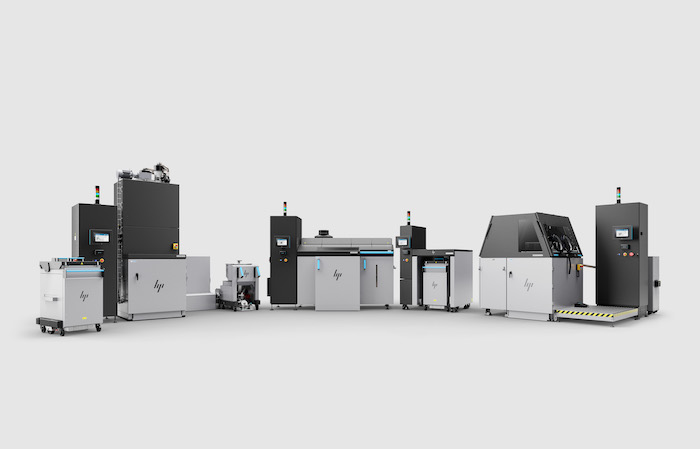Register now for our Additive Manufacturing Advantage online event for insights on AM developments in aerospace, space, and defense sectors from industry leaders!
International technology company, HP made a number of announcements at the RAPID + TCT event.
These offerings include new materials, improved operational efficiencies, and strategic partnerships aimed at broadening the applications of industrial 3D printing. Central to HP’s presentation was the HP Metal Jet S100 Printing Solution, which boasts an extended build height of up to 170 mm.
This allows for the production of larger parts and increases output per build cycle, providing manufacturers with greater flexibility in design. By utilizing Metal Injection Molding (MIM) powders, the solution aims to reduce operational and material costs compared to traditional 3D printing methods. In addition, improved printing process times further enhance industrial productivity, says the company.
“HP is deeply committed to driving the additive manufacturing industry forward with persistent and new enhancements to our existing portfolio,” said Savi Baveja, President of HP Personalization & 3D Printing. “Our innovations in both metal and polymer 3D printing technologies are testament to our dedication to advancing the capabilities and applications of 3D printing, empowering our customers to turn their ideas into reality with unprecedented efficiency and quality.”

HP expands its 3D printing ecosystem
Working with Indo-MIM and Sandvik, HP introduced new materials tailored for specific industrial needs. Among these offerings are IndoMIM M2 Tool Steel, designed specifically for high-strength mold inserts and cutting tools, and Sandvik’s Osprey 316L, which enhances corrosion resistance and processability, catering to medical, automotive, and industrial sectors. Thorough qualification processes ensure the reliability and performance of these advanced materials.
In parallel, HP introduced the HP Metal Jet Production Service, which can be accessed via a dedicated online platform. To broaden its adoption across multiple industries, The service aims to simplify access to metal additive manufacturing, addressing challenges like cost and complexity. Supporting this initiative is the newly established HP Metal Jet Adoption Center in Corvallis, Oregon, providing comprehensive support from prototype validation to full-scale production.
Additionally, HP has teamed up with software giants in a multi-pronged approach to enhance its 3D printing solutions. Partnering with Autodesk, HP seeks to make the Autodesk Fusion bundle work seamlessly with HP printers, for a smoother design-to-production transition. An alliance with Altair will equip users with exclusive HP material information within their software, offering optimized 3D printing designs.

CoreTechnologie’s partnership with HP integrates a wide-ranging digital texture library into the 4D_Additive software to offer texturing options for 3D printed parts. Lastly, HP and Dyndrite together aim to facilitate seamless job management across its 3D printing ecosystem, improving operational efficiency.
A notable addition is the HP 3D Texture Visualizer, developed by Leopoly, which significantly improves the design process by enabling real-time application and visualization of digital textures on CAD models. This tool enables users to customize textures with precise control over scaling, depth, and resolution, enhancing design flexibility and aesthetic outcomes.
A wave of innovation at RAPID + TCT 2024
3D Printing Industry attended this year’s RAPID + TCT event to inspect new technology and speak with from industry leaders.
3D Systems introduced the EXT 800 Titan Pellet, boasting high-speed extrusion and a large build volume suitable for smaller workspaces. On the other hand, BigRep launched the VIIO 250 and ALTRA 280, emphasizing automation and dual extrusion capabilities for large-scale parts.
Additive Industries presented the MetalFab 300 Flex, offering a flexible build area ideal for diverse manufacturing needs. 3D printer OEM Stratasys also unveiled the J5 Digital Anatomy 3D printer to address the rising demand for affordable and precise anatomical models.
Developments in materials and post-processing included XJet introducing 17-4PH stainless steel for industrial applications, while Lithoz launched the Ceramic 3D Factory for distributed manufacturing. Addiblast showcased the MARS04, a de-powdering station for large metal parts, enhancing post-processing efficiency.
In software, nTop unveiled nTop 5 with expanded integration capabilities, enhancing design flexibility across various applications. Meanwhile, Ai Build exhibited its Aibuild 2.0 software, featuring AI-powered tool-path generation and improved user accessibility.
Join the Expert Committee for the 2024 3D Printing Industry Awards to help select the winners!
What 3D printing trends do the industry leaders anticipate this year?
What does the Future of 3D printing hold for the next 10 years?
To stay up to date with the latest 3D printing news, don’t forget to subscribe to the 3D Printing Industry newsletter or follow us on Twitter, or like our page on Facebook.
While you’re here, why not subscribe to our Youtube channel? Featuring discussion, debriefs, video shorts, and webinar replays.
Featured image shows HP’s Metal Jet S100 Printing Solution. Image via HP.


